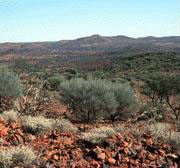
Young gully landforms on Mars, discovered in high-resolution images from the Mars Global Surveyor Mars Orbiter Camera, are generally believed to have formed by erosion from flowing liquid water. Such evidence for recent liquid water outflows on Mars suggests that these events occurred under present climatic conditions with mean surface temperatures of -60°C and extensive permafrost. Recent spring activity on Mars is effectively studied by examining perennial cold water saline springs in the Canadian High Arctic since this polar desert provides an accessible Earth analog to the martian environment. The martian gully systems are also examined through an analysis of Mars Orbiter Camera (MOC) imagery, Mars Orbiter Laser Altimeter (MOLA) data, and Thermal Emission Spectrometer (TES) thermal inertia data from the Mars Global Surveyor spacecraft. Such observations are used to constrain a theoretical model of surficial liquid flow in both the Arctic and on Mars to explain the occurrence of liquid water outflows in these polar desert environments. A synthesis of the Arctic studies, spacecraft data analysis, and numerical modeling efforts suggests that the martian gullies formed from the release of relatively pure liquid water from a subsurface aquifer under current martian environmental conditions. The simultaneous freezing and boiling of pure liquid water on the martian surface has created the gully systems observed today, and hence these water-rich sites should be considered as prime astrobiological targets in the search for past or present life on Mars.
 A Record of the Earliest (4.5-3.8 Ga) Surface Conditions on Earth?
A Record of the Earliest (4.5-3.8 Ga) Surface Conditions on Earth? Simulating Groundwater Radiolysis With Oxidation of Pyrite by Hydrogen Peroxide Solution
Simulating Groundwater Radiolysis With Oxidation of Pyrite by Hydrogen Peroxide Solution Exploring Planet-Forming and Debris Disks
Exploring Planet-Forming and Debris Disks Quantifying Water Production in Comets - The "Meter Stick" for Their Chemical Taxonomy
Quantifying Water Production in Comets - The "Meter Stick" for Their Chemical Taxonomy